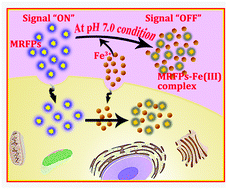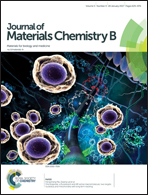Bio-friendly Maillard reaction fluorescent products from glutathione and ascorbic acid for the rapid and label-free detection of Fe3+ in living cells†
Abstract
Developing probes with good biocompatibility and realizing intracellular detection in living cells are of great significance for biomedicine and life sciences, but remain a challenge presently. In this paper, we describe a rapid and highly selective biosensor for Fe3+ detection in living cells based on the Maillard reaction fluorescent products (MRFPs) of glutathione and ascorbic acid as a probe. Experiments show that the MRFPs are non-cytotoxic and possess excellent biocompatibility. Moreover, the MRFPs show a rapid response and good selectivity towards Fe3+ over other metal ions under physiological pH conditions in vitro. The introduction of Fe3+ can quench the fluorescence of MRFPs, and the fluorescence intensity of system decreases linearly with the increasing concentration of Fe3+ in the range of 0.05–50 μM with the detection limit of 4.6 nM at a signal-to-noise ratio of 3. Moreover, the recognition mechanism has been discussed, which is attributed to the charge transfer from excited-state MRFPs molecules to metal ions. In addition, the MRFPs have been successfully demonstrated to be a good imaging probe for Fe3+ sensing in living cells. This study shows that the biocompatible MRFPs might hold great potential for applications in bioimaging, diagnosis, and therapy of intracellular diseases.



 Please wait while we load your content...
Please wait while we load your content...